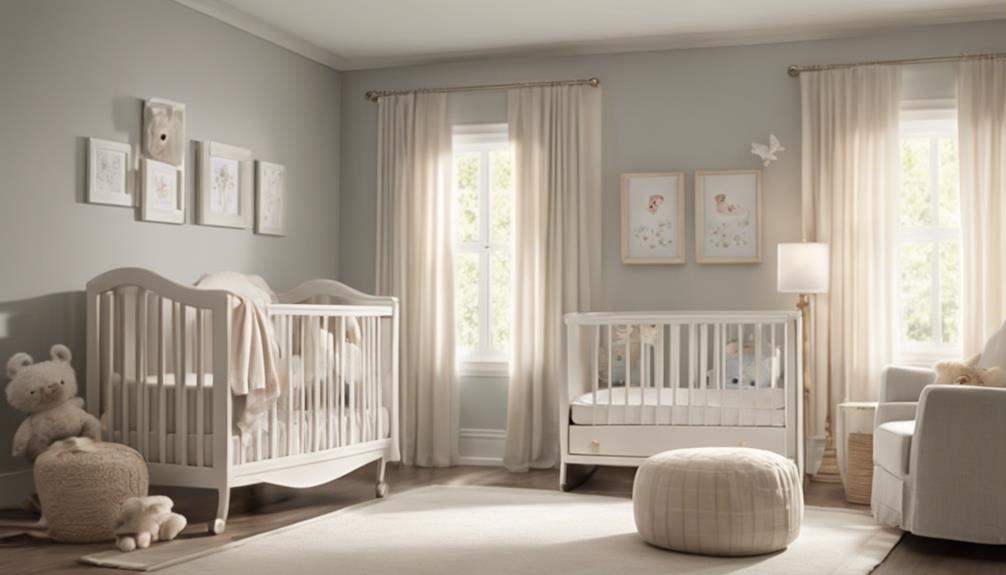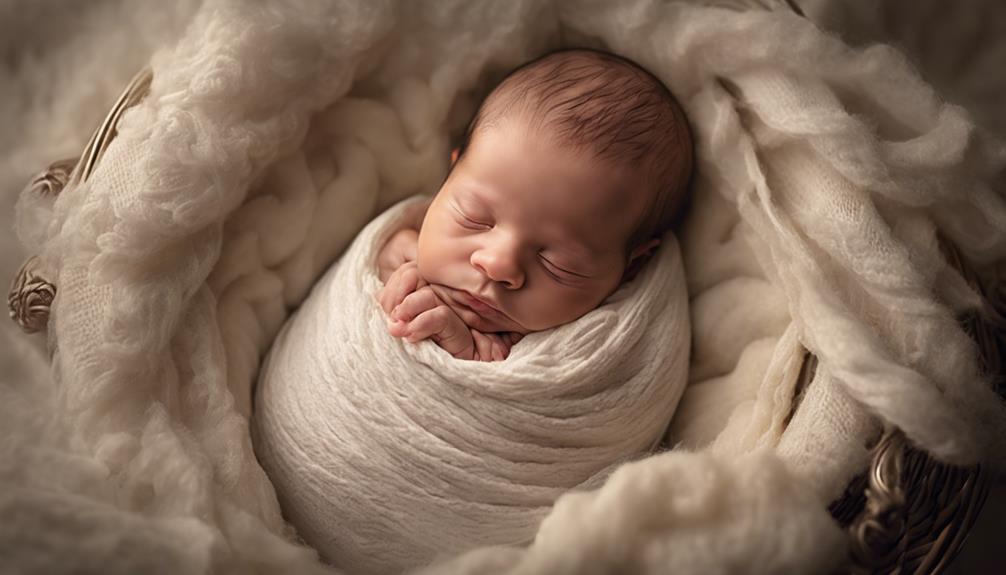When it comes to putting your newborn to sleep tonight, there might be a vital step you haven't considered yet. It involves a simple technique that can make a significant difference in your baby's sleep quality.
By implementing this method, you'll not only guarantee a peaceful night for your little one but also set the stage for a smoother bedtime routine.
Stay tuned to discover how this small adjustment can lead to a more restful night's sleep for both you and your baby.
Key Takeaways
- Swaddle your newborn snugly for a womb-like comfort and better sleep.
- Establish a consistent bedtime routine for healthy sleep patterns.
- Engage in daytime interactions to promote development and aid nighttime sleep.
- Use pacifiers to reduce SIDS risk, establish soothing associations, and aid self-soothing.
Comfort Is Key
When it comes to ensuring your newborn gets the best sleep possible, prioritizing comfort is essential. Creating a cozy environment for your little one involves factors like swaddling for security, choosing a suitable crib mattress, and maintaining the right room temperature. Swaddling your newborn not only offers a sense of security but also helps mimic the womb environment, promoting better sleep. Opt for a comfortable and firm mattress in the crib to provide adequate support for your baby while they rest. Keeping the room temperature between 68-72°F contributes to an ideal sleep environment for your newborn.
It's important to follow safe sleep practices recommended by pediatric experts, such as placing your baby on their back to sleep. This position reduces the risk of suffocation and Sudden Infant Death Syndrome (SIDS). By ensuring your newborn is in a secure, cozy, and safe sleep environment, you're setting the stage for peaceful and restful nights for both your baby and yourself.
Swaddling for Security

Swaddling your newborn creates a secure and comforting environment that mimics the womb, promoting a sense of safety and aiding in better sleep. Newborns are accustomed to the snug surroundings of the womb, and swaddling helps replicate this sensation, preventing the startle reflex that can disrupt their sleep. By securely wrapping your baby in a swaddle, you provide a sense of security that allows them to rest more soundly.
In addition to promoting better sleep, swaddling can be incredibly calming for fussy or colicky babies. The gentle pressure of a swaddle can help soothe your little one, making them feel more relaxed and settled. This can lead to longer periods of uninterrupted sleep for both the baby and the tired parents. Remember, when swaddling your newborn, make sure the wrap is snug but not too tight, allowing for comfort and proper movement.
Swaddling is a simple yet effective technique that can help your baby feel safe and secure as they drift off to sleep.
Establishing Sleep Routines

To help your newborn establish healthy sleep patterns, creating a consistent bedtime routine is key. Babies thrive on predictability and structure in their sleep schedules, so establishing a calming environment signals to your baby that it's time to sleep. Incorporating soothing activities like gentle rocking or lullabies aids in bedtime preparation and can help your little one relax before sleep. Following a set routine each night can promote better sleep habits for your newborn, setting the stage for more restful nights for both baby and parents.
| Bedtime Routine Activities | Description |
|---|---|
| Dim the lights | Helps signal bedtime |
| Gentle rocking | Calming for the baby |
| Warm bath | Soothes and relaxes |
| Lullabies | Promotes sleepiness |
Daytime Attention Matters

Establishing a strong bond with your newborn through engaging daytime interactions is important for promoting healthy development and better sleep patterns at night. Spending quality time with your baby during the day can have a significant impact on their nighttime routine. Here are a few ways how daytime attention matters:
- Creating Security: Babies thrive on feeling secure and loved, and providing them with attention during the day creates a sense of security that can help them relax and fall asleep easier at night.
- Building Routine: Establishing a consistent schedule of interaction during the day can make it easier for babies to predict when it's time for sleep, helping them develop a more structured routine.
- Encouraging Rest: Engaging activities during the day can help babies expend energy, making them more likely to fall asleep peacefully when bedtime arrives.
- Enhancing Comfort: Daytime attention can help reassure babies that they're cared for, setting a positive emotional tone that can make it easier for them to sleep through the night.
Pacifiers and Preferences

Engaging with your newborn during the day can pave the way for introducing pacifiers and understanding their preferences for better sleep routines.
Pacifiers play a vital role in reducing the risk of Sudden Infant Death Syndrome (SIDS) by up to 50% while providing a comforting tool for soothing babies' natural sucking instinct. Incorporating a pacifier at naptime and bedtime helps establish a sleep association, aiding in self-soothing and promoting better sleep patterns.
Recognizing that some babies may have a preference for specific pacifiers based on factors like shape, size, or material. By observing your baby's reactions and comfort levels, you can identify the pacifier that best suits their needs, contributing to a more peaceful sleep environment.
Embracing pacifiers as part of your baby's sleep routine not only enhances their soothing capabilities but also fosters healthy sleep habits for the best rest and well-being.
Frequently Asked Questions
How Can I Get My Newborn to Fall Asleep Faster?
We've found that swaddling, establishing a bedtime routine, avoiding overstimulation, using white noise, and ensuring basic needs are met can help newborns fall asleep faster. Consistency and a calm environment are key for restful nights.
How Can I Make My Newborn Sleep at Night?
We empathize with the struggle of getting a newborn to sleep at night. Consistent bedtime routines, a soothing sleep environment, and responsive care to their needs can help. Remember, it's a team effort for peaceful nights.
What Is the Best Way to Lay a Newborn Down to Sleep?
We lay our newborn down on their back, following the AAP's advice to reduce SIDS risk. No loose bedding, firm mattress, snug fit. Sleep sack or swaddle for warmth. Room at 68-72°F. Safe, sound sleep for our little one.
How Can I Stimulate My Newborn to Sleep?
To help your newborn sleep, we swaddle snugly, rock gently, and create a soothing bedtime routine. Dark, quiet spaces and calm activities signal it's time to rest. Avoid overstimulation; instead, offer gentle lullabies and warmth for peaceful slumber.
Conclusion
As we tuck our precious newborns into bed tonight, let's remember the importance of creating a comfortable sleep environment.
By swaddling them securely, establishing soothing routines, and providing attention during the day, we can help them drift off into a peaceful slumber.
Let's embrace these practices and watch as our little ones sleep soundly, knowing they're safe and content in their cozy sleep space.
Goodnight, sweet dreams to all!









